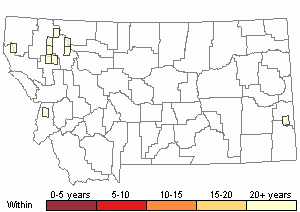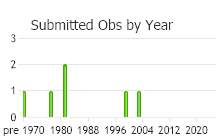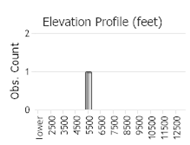View in other NatureServe Network Field Guides
NatureServe
Montana
Utah
Wyoming
Idaho
Wisconsin
British Columbia
South Carolina
Yukon
California
New York
Petite Pocket Moss - Fissidens bryoides
General Description
Plants: Stems ascending to erect, 3-11 x 0.9-3.2 mm, simple and branched. Light to dark green.
Leaves: When dry, leaves are crisped and contorted. Leaves paired (up to 20 pairs), lanceolate, oblong-lanceolate, to oblong-lingulate, and 0.8-2.7 x 0.2-0.5 mm. Apex acute to short-acuminate or obtuse-apiculate. Vaginant lamina about 1/2 the length of leaf. Margin entire though usually serrulate near the apex and with a border. Dorsal lamina is slightly decurrent. Costa ending 6 or less cells from the apex to excurrent.
Leaf Cells: Laminal cells of 1-layer, smooth, slightly bulging, irregularly hexagonal with some being elongate. Margin of 1-3 layers in X-S.
Diagnostic Characteristics
Because of their vaginant leaf, Fissidens are often confused for liverworts, particularly Diplophyllum.
Range Comments
Greenland; Canada: AB, BC, NB, NL (Nfld.), NT, NS, NU, ON, PE, QC, YT; United States: AL, AK, AZ, AR, CA, CO, CT, DE, FL, GA, ID, IL, IN, IA, KS, KY, LA, ME, MD, MA, MI, MN, MS, MO, MT, NH, NJ, NM, NY, NC, ND, OH, OK, OR, PA, RI, SC, SD, TN, TX, UT, VT, VA, WA, WV, WI, WY; Mexico; West Indies; Central America; South America; Europe; Asia (FNA 2007). In Montana, known from Carter, Fallon, Flathead, Glacier, Lake, Lincoln, Ravalli, and Valley Counties (Elliott 2016).
Observations in Montana Natural Heritage Program Database
Number of Observations: 24
(Click on the following maps and charts to see full sized version)
Map Help and Descriptions
Relative Density

Recency



 (Observations spanning multiple months or years are excluded from time charts)
(Observations spanning multiple months or years are excluded from time charts)
Habitat
On soil, stones, and rocks in moist, shaded sites and along streams, sometimes inundated. Rarely around tree bases.
Reproductive Characteristics
Seta 1.4-10 mm tall. Capsules exserted, erect, radially symmetrical to somewhat inclined, and 0.2-1.2 long. Calyptra cucullate, smooth, and 0.5 mm or less long. Polyoicous.
Naked antheridia and archegonia often in axils of distal leaves with 1-2 sporophytes per perichaetium.
Stewardship Responsibility
References
- Literature Cited AboveLegend:
 View Online Publication
View Online Publication Elliott, J.C. and A.K. Pipp. 2018. A Checklist of Montana Mosses (1880-2018). Updated 3 January, 2020. Montana Natural Heritage Program, Helena, Montana. 73 pp.
Elliott, J.C. and A.K. Pipp. 2018. A Checklist of Montana Mosses (1880-2018). Updated 3 January, 2020. Montana Natural Heritage Program, Helena, Montana. 73 pp. Flora of North America Editorial Committee, eds. 2007. Flora of North America North of Mexico. Volume 27. Bryophytes: Mosses, Part 1. Oxford University Press, Inc., NY. xxi + 713 pp.
Flora of North America Editorial Committee, eds. 2007. Flora of North America North of Mexico. Volume 27. Bryophytes: Mosses, Part 1. Oxford University Press, Inc., NY. xxi + 713 pp.
- Additional ReferencesLegend:
 View Online Publication
View Online Publication
Do you know of a citation we're missing? Elliot, J. C. 1993. Second checklist of Montana mosses. Unpublished report. U.S. Forest Service, Region 1. Missoula, MT. 45 pp.
Elliot, J. C. 1993. Second checklist of Montana mosses. Unpublished report. U.S. Forest Service, Region 1. Missoula, MT. 45 pp. Lawton, E. 1971. Keys for the Identification of the Mosses on the Pacific Northwest. Reprinted from 'Moss Flora of the Pacific Northwest'. Published as Supplement No. 2 of the Journal of the Hattori Botanical Laboratory. Nichinan, Miyazaki, Japan. 66 pp.
Lawton, E. 1971. Keys for the Identification of the Mosses on the Pacific Northwest. Reprinted from 'Moss Flora of the Pacific Northwest'. Published as Supplement No. 2 of the Journal of the Hattori Botanical Laboratory. Nichinan, Miyazaki, Japan. 66 pp. Lawton, E. 1971. Moss Flora of the Pacific Northwest. Hattori Botanical Laboratory. Japan: Yamabuki-cho, Shinjuku-ku, Tokyo. 362 pages plus appendices.
Lawton, E. 1971. Moss Flora of the Pacific Northwest. Hattori Botanical Laboratory. Japan: Yamabuki-cho, Shinjuku-ku, Tokyo. 362 pages plus appendices.
- Web Search Engines for Articles on "Petite Pocket Moss"





